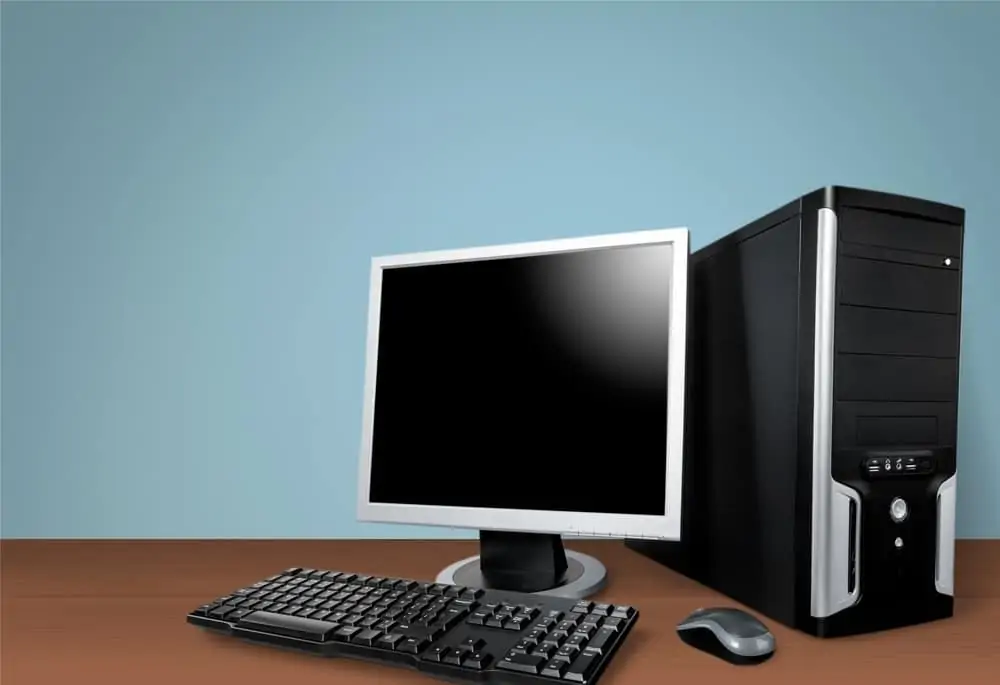Dell OptiPlex 780: At First Glance
Dell has long been one of the leading manufacturers of desktop computers. The affordability of Dell’s computers can be credited with the company’s success.
The OptiPlex 780 is one of Dell’s most affordable products. The Dell OptiPlex 780 is a PC marketed to small businesses or home users for performing basic computing tasks.
As mentioned earlier, this desktop is quite affordable, therefore; its starting price is as little as $117.90. It is worth noting that this price was accurate as of September 2021 when I published this article.
In addition to its low price, the Dell OptiPlex 780 come packed with a lot of perks and decent performance. I am going to be discussing these perks and the desktop’s performance in the remainder of this review.
So, if you want to find out more about the Dell OptiPlex 780, read on!
Dell OptiPlex 780: Design, Dimension & Weight
The Dell OptiPlex 780, like other Dell OptiPlex desktops, has a metal chassis. This metal chassis ensures the desktop’s long-term functionality and robustness.
Furthermore, the OptiPlex 780 is also available in three different form factors. Users can select the size that best suits their preferences or workspace thanks to the variety of form factors available.
The form factors include Mini-Tower, Desktop, Small, and Ultra Small. The “Mini-Tower” form factor is the biggest amongst them – it measures 187 x 433 x 408 mm and weighs 11700 g.
The “Desktop” form factor, on the other hand, measures 399 x 353 x 114 mm and weighs 8260 g. This form factor is like the size of a typical desktop that is why it is called the “Desktop” form factor.
Furthermore, the “Small” form factor, as the name implies, is quite small, but not as small as the “Ultra-Small”. The “Small” form factor measures 314 x 340 x 92.6 mm and weighs 6800 g.
Lastly, is the “Ultra-Small” form factor, which is the smallest amongst the form factors of the Dell OptiPlex 780. It measures just 65 x 236 x 239 mm and weighs 3200 g.
It is worth noting that the Dell OptiPlex 780 I reviewed has an “Ultra-Small” form factor. Due to its very small size, it features a fewer number of ports than on other OptiPlex 780 form factors.
Specifically, my review desktop features 7 USB 2.0 ports – 2 on the front side and 5 on the rear. Compared to the 9 USB 2.0 ports (2 on the front, 6 on the back, and 1 internally) found on other OptiPlex 780 form factors.
Furthermore, my review desktop also features a DisplayPort, Serial port, Ethernet port, a VGA port, an eSATA port on its rear. In addition to that, there is an optical drive, microphone, and headphone jacks on its front side.
Still, on its front side, there is a shiny Dell logo just beside the power button. Additionally, there is ventilation on the desktop’s front side.
A desktop computer is not usable without devices such as the keyboard, mouse, and monitor. Thankfully, Dell offers the OptiPlex 780 with a keyboard, mouse, and a monitor, despite the desktop’s low price.
The monitor is a 22-inch widescreen LCD display. This monitor is quite disappointing: the colors are dull, the brightness poor, and the whites looks kind of gray.
Thankfully, the keyboard and mouse make up for the error made on the monitor. The keyboard’s keys and mouse’s click buttons have a decent amount of key travel, with just a bit of noise when pressed.
However, don’t expect to find any application-launching buttons on the keyboard or DPI toggles on the mouse. DPI toggles are used to adjust a mouse’s sensitivity level and also show the sensitivity level through a sequence of LED lights.
Application-launching buttons, on the other hand, are dedicated keys on a keyboard that automatically launch specific applications.
Moving on, my review desktop was very easy to disassemble. Just a single screw at the top can open the right side of the desktop.
The side of the desktop gives you access to the inside, where you can service and upgrade the desktop’s hardware.
The Dell OptiPlex 780 I reviewed came with a Windows 7 operating system. However, Windows Vista and Windows XP are also supported on the desktop.
Moreover, asides from the Windows 7 OS and drivers for all the components, my review desktop didn’t come with any bloatware. This is actually a good thing because I didn’t have to be deleting unnecessary bloatware which I don’t need.
Additionally, lack of bloatware is actually what most users expect from a fresh-out-of-the-box business desktop. This is because an unnecessary amount of bloatware may cause the system to lag.
Besides that, bloatware consumes quite a lot of storage space.
As mentioned at the beginning of this review, I will be comparing the Dell OptiPlex 780 with similar desktops. So, in this design review section, I will be comparing the desktop’s weight with other desktop’s weight.
If you recollect, I mentioned earlier that my review desktop is an “Ultra-Small” form factor which weighs 3200 g. Comparatively, the Dell OptiPlex 780 Ultra Small weighs less than HP’s Grade A Compaq 8000 Elite Ultra Small.
Specifically, the HP Grade A Compaq 8000 Elite Ultra-Small form factor weighs 7600 g. Furthermore, when compared to its predecessor, the Dell OptiPlex 780 Ultra Small form factor also weighs less.
The Ultra-Small form factor of its predecessor, the Dell OptiPlex 760 weighs 6019 g.
In conclusion, the Dell OptiPlex 780 is available in different form factors, which is quite impressive. Additionally, it offers a monitor, keyboard, and mouse, despite its affordable price.
Moreover, it features quite a number of ports. Therefore, I will rate the Dell OptiPlex 780 a nine out of ten in this design review section.
Dell OptiPlex 780: Processor (CPU) Performance
Just like its form factor, the Dell OptiPlex 780 offers multiple processors to choose from. You can either get the desktop with an Intel Celeron 3300, Intel Core 2 Duo E8600, or Intel Core 2 Quad Q9650 processor.
The Intel Celeron 3300 is a dual-core processor with a 2.50 GHz base frequency and a 1 MB cache memory. The Intel Core 2 Duo E8600, on the other hand, is also a dual-core processor but has a 3.33 GHz base frequency.
In addition to its base frequency, it has a cache memory of 6 MB.
Lastly, the Intel Core 2 Quad Q9650, which my review desktop came with, is a quad-core processor. Additionally, this processor has a base frequency of 3.0 GHz and a cache memory of 12 MB.
Just like the other processor options, the Intel Core 2 Quad Q9650 is quite an outdated processor. You will barely find it on desktops in 2021.
However, despite its old age, the Intel Core 2 Quad Q9650 is still capable of handling basic computing tasks. Therefore, my review desktop was able to perform tasks like internet browsing, word processing, and light multitasking with ease.
However, complex tasks like video editing or gaming are a no-go-area for the Dell OptiPlex 780 I reviewed. Furthermore, I carried out a Worldbench 6 test on my review desktop to further determine its processor performance.
Worldbench 6 stimulates real-world computing tasks and provides a score based on how a desktop performed – a higher score means better performance. Based on the Worldbench 6 results, the Dell OptiPlex 780 I reviewed scored 116 points.
Comparatively, the Lenovo ThinkCentre M58p’s score is almost on par with the Dell OptiPlex 780’s score. On the Worldbench 6 test, the Lenovo ThinkCentre M58p which runs on an Intel Core 2 Duo E8500 processor scored 113 points.
Moreover, when compared to its predecessor, the Dell OptiPlex 780 performed better. Its predecessor, the Dell OptiPlex 760 scored 100 points on the Worldbench 6 test.
It is crucial to note that the Dell OptiPlex 760 uses an Intel Core 2 Quad Q8300 processor.
Finally, I will be rating the Dell OptiPlex 780 a seven out of ten in this processor review. This rating is based on the fact that it performs slightly better than one of its competitors.
Dell OptiPlex 780: Memory (RAM) Performance
Dell equips the OptiPlex 780 with 1 GB 1066 MHz DDR2 RAM as standard. However, the number of RAM slots you get depends on the Dell OptiPlex 780 form factor you purchase.
Specifically, all the form factors, except the Ultra-Small form factors feature four RAM slots. Additionally, each slot supports a maximum RAM capacity of 2 GB, totaling 8 GB combined.
However, the Ultra-Small form factor, which the Dell OptiPlex 780 I reviewed has, features 2 RAM slots. As mentioned earlier, each RAM slot supports a max RAM capacity of 2 GB.
Therefore, the Dell OptiPlex 780 Ultra-Small form factor supports a total maximum RAM capacity of 4 GB. My review desktop features the 4 GB maximum RAM supported.
The Dell OptiPlex 780 I reviewed was able to multitask adequately with its 4 GB but not too adequate. As a result, I was able to open 7 Chrome tabs, but most of the tabs took few seconds to load.
However, launching other applications when these Chrome tabs open was a bit of a problem. The applications kept on crashing and even the ones that managed to open took a while.
Nonetheless, with just the 7 Chrome tabs opened, the Dell OptiPlex 780 held a decent performance with few lags. Furthermore, a PCMark Vantage test was carried out to further determine the desktop’s performance with 4 GB RAM.
PCMark Vantage is a benchmark test that assesses the productivity performance of a computer. At the end of the PCMark Vantage test, the Dell OptiPlex 780 recorded a score of 4910 points.
This score is the same as the category average. However, the Lenovo ThinkCentre M58p got a slightly higher score, recording a score of 5083 points.
On the plus side, the Dell OptiPlex 780 performs better than its predecessor, the Dell OptiPlex 760. The Dell OptiPlex 760 scored 4219 points on the PCMark Vantage test.
Finally, I will rate the Dell OptiPlex 780 a seven out of ten in this memory review section.
Dell OptiPlex 780: Storage Options & Performance
In terms of storage, the Dell OptiPlex 780 comes with a SATA 7200 RPM HDD. This SATA 7200 RPM HDD can accommodate a maximum storage capacity of 1 TB.
Furthermore, the Dell OptiPlex 780 I reviewed came with a maximum of 1 TB SATA 7200 RPM HDD.
A storage capacity of 1 TB should be more than enough for most businesses and users. If not, Dell also included a 19-in-1 Media Card Reader for storage expansion.
However, this feature is only available in the Dell OptiPlex 780 Mini Tower, Desktop, and Small form factor. Hence, it isn’t available in the Dell OptiPlex 780 Ultra-Small form factor.
To determine the speed of the Dell OptiPlex 780’s SATA 7200 RPM HDD, I ran a CrystalDiskMark test.
CrystalDiskMark is a freeware disk drive benchmarking program for Windows. It assesses the read and write speeds of a computer’s hard disk drive (HDD) or solid-state drive (SSD).
According to the CrystalDiskMark test, the Dell OptiPlex 780’s HDD has a sequential read speed of 92 MBps. In addition to that, it has a sequential write speed of 97.6 MBps.
When compared to its OptiPlex sibling (Dell OptiPlex 7010), the Dell OptiPlex 780 has a slower read and write speed. On the test, the Dell OptiPlex 7010 recorded a sequential read and write speed of 104.3 MBps and 101.1 MBps respectively.
However, in comparison with its predecessor, the OptiPlex 780 has a slightly faster sequential read and write speed. Its predecessor, the OptiPlex 760, has a sequential read and write speed of 87.5 MBps and 93.3 MBps respectively.
Summing up, the Dell OptiPlex 780 features a sufficient 1 TB HDD storage which is quite impressive. Hence, the Dell OptiPlex 780 will get a rating of 8 in this storage review section.
Dell OptiPlex 780: Graphics Card Performance
Impressively, for a desktop in this price range, the Dell OptiPlex 780 comes with numerous graphics card options. The graphics card options include an Intel GMA 4500, ATI RADEON HD 3450, and ATI RADEON HD 3470 graphics card.
That is not all, it also includes an NVIDIA GeForce 9300 GE and NVIDIA Quadro NVS 420 graphics card. All five graphics card options are dedicated graphics cards with 256 MB DDR2 dedicated VRAM except the Intel GMA 4500.
The Intel GMA 4500 is an integrated graphics card with only a base GPU frequency of 533 MHz. Additionally, it also lacks a dedicated VRAM because it is an integrated graphic card.
Therefore, it has to share the system memory with the CPU. As a result, it won’t have enough power to run graphically intensive applications or games.
Now for the dedicated graphics card options clock speed (GPU frequencies). The ATI RADEON HD 3450 has a base GPU frequency of 600 MHz.
The ATI RADEON HD 3470 graphics card, on the other hand, has a base GPU frequency of 800 MHz. The NVIDIA GeForce 9300 GE has a base and boost GPU frequency of 540 MHz and 1300 MHz respectively.
Lastly, the NVIDIA Quadro NVS 420 has a base and boost GPU frequency of 550 MHz and 1400 MHz respectively. My review desktop came with the NVIDIA Quadro NVS 420 graphics card.
Despite featuring a dedicated graphics card, the Dell OptiPlex 780 I reviewed is unable to run the latest game titles. This is because, its graphics card (NVIDIA Quadro NVS 420) is an outdated graphics card, just like the other graphics card options.
Therefore, the Dell OptiPlex 780 I reviewed was only able to run outdated games. However, it delivered a smooth frame rate when playing outdated games such as FIFA 11.
While playing FIFA 11, the Dell OptiPlex 780 I reviewed delivered a frame rate of 121 fps. Also, while playing another outdated game like Doom 3, it delivered an impressive 102 fps.
Moving on, I carried out a 3DMark 06 to further determine the graphics performance of my review desktop. 3DMark 06 is a benchmark test for measuring how well a computer can render 3D graphics.
The Dell OptiPlex 780 I reviewed scored 1233 points, based on the 3DMark 06 results. Comparatively, it got a better score than its predecessor, the Dell OptiPlex 760.
The Dell OptiPlex 760 scored 1124 points on the 3DMark 06 test. It is worth noting that the Dell OptiPlex 760 uses an NVIDIA GeForce 9300 GE graphics card.
In conclusion, the Dell OptiPlex 780 features various graphics options, which is very impressive. However, all its graphic card options are outdated.
Therefore, they can’t run modern games.
As a result, I will be rating the Dell OptiPlex 780 a seven in this graphics card review section.
Frequently Asked Questions
Dell released the OptiPlex 780 in 2010. As a result, the Dell OptiPlex 780 is approximately 11 years old when this review was published in September 2021.
The Dell OptiPlex 780 Ultra Small form factor I reviewed has seven USB 2.0 ports. However, the other form factors have about 9 USB 2.0 ports.
No. The Dell OptiPlex 780 isn’t a gaming desktop. However, it features some outdated graphics card options that are capable of playing only old games like FIFA 11.
No, it doesn’t.
The Dell OptiPlex 780 starting price was $117.90 when I wrote this article in September 2021.
Conclusion
The Dell OptiPlex 780 is an affordable desktop computer that is designed for handling basic computing tasks. Furthermore, this desktop features quite a lot of ports which enhances its productivity.
Moreover, despite its very low starting price, it comes with a monitor, keyboard, and mouse. However, its monitor is somewhat poor – therefore, you may have to purchase a new monitor if you really mean business.
Additionally, the desktop performance is pretty decent, but it isn’t capable of running complex tasks. On the plus side, the Dell OptiPlex 780 is available in different form factors.
I hope you found this Dell Optiplex 780 desktop review helpful. If you found the review helpful, kindly click Yes to “Was this page Helpful?” below.
You could also share your thoughts with the “Leave a Comment” form found at the end of this page.
Finally, for more laptop reviews, visit our PC & Mac Reviews page. You may also find our PC & Mac Specs page very helpful.



